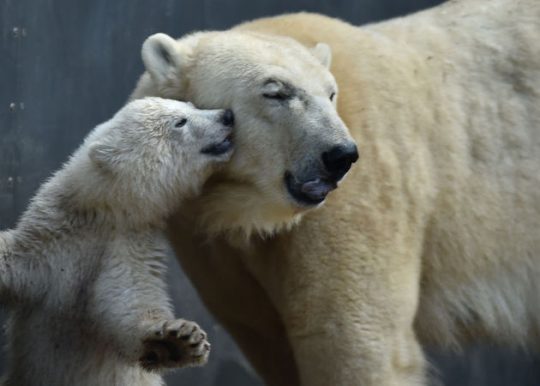The New York Times has come up with a new defense against so-called climate denialists who happen to point out that most polar bear populations are steady or increasing amidst climate change: The ice hasn't disappeared as fast as we said it would.
"Climate Change Denialists Say Polar Bears Are Fine," the Times scoffed this week. "Scientists Are Pushing Back."
Well, scientists and the Times, that is. The Times is upset that the "denialists" have stolen the polar bear away from the alarmists, who for years have warned that our SUVs are killing the bears off.
"Furry, button-nosed and dependent on sea ice for their survival, polar bears have long been poster animals for climate change," the Times writes. "But at a time when established climate science is being questioned at the highest levels of government, climate denialists are turning the charismatic bears to their own uses, capitalizing on their symbolic heft to spread doubts about the threat of global warming."
And we can't have that, can we?
No, only the Times is allowed to tell us what polar bears can and cannot be used for. But the story isn't really about the bears. It's about shutting down the other side of the debate.
One has to get to the 26th paragraph of the article to figure out just how the polar bears are doing. And, actually, it's not too bad!
"Of the 19 polar bear subpopulations in the Arctic Circle, three have shown substantial declines, including bears in the South Beaufort Sea off Alaska's coast and in West Hudson Bay in Canada," the Times writes. "One subpopulation has increased in numbers, and scientists know little or nothing about nine of the others, which are either in Russian territory or in locations so remote that resources are not available for surveys."
Didn't catch that? Some polar bear populations are increasing. And the Times should have fact-checked their numbers, because according to the World Wildlife Fund, no "denialists" themselves, two populations are actually increasing, and only one—not three—is in decline.
"Although most of the world's 19 populations have returned to healthy numbers, there are differences between them," the World Wildlife Fund says. "Some are stable, some seem to be increasing, and some are decreasing due to various pressures."
So, as of 2017 only one population was in decline, two were increasing, seven were stable, and nine we don't know. But the Times won't fall for those numbers.
"But to hear climate denialists tell it, polar bears are doing just fine," the Times writes. "Predictions about devastating declines in polar bear populations, they say, have failed to materialize."
The point of the Times piece is to promote a new paper that pillories blogs that dare to question the orthodoxy of climate science. Their main target is Dr. Susan Crockford, a zoologist and anthropology professor at the University of Victoria in British Columbia who runs the blog Polar Bear Science that promises "science without advocacy, fearmongering or spin."
"Most importantly," she says, "there will be no predictions about the future of polar bears!"
Seems reasonable.
But the Times says Crockford is "using the bears to spread misinformation about the causes and consequences of climate change." (She had the audacity to point out that polar bear numbers have not yet plummeted after dire predictions in 2007.)
The Times got the authors of the paper published in BioScience to pile on Crockford and accuse her of spreading "dubious information." The merry scientists were just "banding together against climate change denial."
But what exactly is Crockford wrong about? The Times itself had to admit that the "denialist" Crockford forced two corrections in the hit BioScience article against her.
A government report predicted "two-thirds of the world's polar bears could be lost by the middle of this century" in 2007, when arctic sea ice hit an all-time low.
It was an all-time low. And then it increased every year until 2012, when it hit another all-time low. Yearly averages have been above that ever since at 4.5 million square kilometers. Until this year, when it hit an all-time low for January and is now hovering around 2007 levels. It seems to go up and down.
Now the same scientist that predicted all the polar bears would be gone with only one million square kilometers or less of ice by 2050 says the "denialists" are wrong because we aren't anywhere near close to that.
Back then scientists thought the sea ice "might be vanishing faster than the available computer models predict."
Now? The Times reports that sea ice extent is "nowhere near the low levels projected" by 2050.
"To say that we already should have seen those declines now when we're not nearly to the middle of the century yet is absurd," says Steven Amstrup, who cowrote the 2007 government paper that predicted the doom and gloom for the bears. In other words: Give us time to kill the bears off!
It also might be absurd to predict what will happen a century from now. Or to demonize critics who point out when the opposite of what you said would happen is happening.
